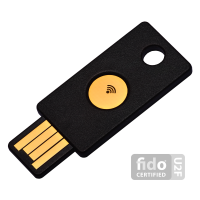Linux Login with Yubikey

Software Installation
This module implements PAM over U2F, providing an easy way to integrate the YubiKey (or other U2F compliant authenticators) into your existing infrastructure.
We don’t need YubiKey NEO Manager, since November 2015 YubiKeys are shipped with all modes of operations alreeady already enabled by default.
$ sudo apt install libpam-u2f
Yubikey Registration
A mappings file needs to be created and filled with the users registered U2F keys.
There is a command-line tool to help with registration process. Replace
${USERNAME} with the name of the user, which belongs to the Yubikey,
if it’s not your own:
$ pamu2fcfg -u${USERNAME} | sudo tee /etc/security/u2f_mappings
Nothing will happen in your console, but your Yubikey should start to blink as
it wants to be touched now. Touch it, the command exits, and the file
/etc/u2f_mappings will contain the necessary challenges for the Yubikey
belonging to that user.
If you a have a second key:
$ pamu2fcfg -n | sudo tee -a /etc/security/u2f_mappings
Configuration
Create a a new PAM service file /etc/pam.d/u2f:
$ echo "auth sufficient pam_u2f.so cue authfile=/etc/security/u2f_mappings debug" > sudo tee /etc/pam.d/u2f
This tells the PAM module that it can look up information about each users U2F
keys in the /etc/u2f_mappings file.
Testing with sudo
Then we can include the file in other PAM service file. For example for the
sudo command edit the file /etc/pamd.d/sudo as follows:
#%PAM-1.0
session required pam_env.so readenv=1 user_readenv=0
session required pam_env.so readenv=1 envfile=/etc/default/locale user_readenv=0
@include u2f
@include common-auth
@include common-account
@include common-session-noninteractive
Make sure line “@include u2f” sits before the “common-auth” include line,
Going Live
Open the PAM service file /etc/pam.d/u2f again and remove the debug string:
$ echo "auth sufficient pam_u2f.so authfile=/etc/security/u2f_mappings" | sudo tee /etc/pam.d/u2f
Open the PAM service file /etc/pam.d/gdm-password and the following line before the “@include common-auth” line:
@include u2f
@include common-auth
Do the same with /etc/pam.d/login and /etc/pam.d/polkit-1.
Lock the Desktop with Yubikey
This is how we setup our desktop to immediately lock Gnome shell desktop sessions, when the Yubikey is removed.
In Linux most hardware devices are managed by the udev service. Using udev-rules actions can be triggered when certain hardware events (device is added or removed) occur. Each USB device has a Vendor ID and a Product ID that can be used to identify the device. For all YubiKeys, Yubico’s USB vendor ID (VID) is 0x1050. Yubico publishes a list of YubiKey USB ID Values where you can see all the Product IDs.
To get a list of all currently attached USB devices on your system:
$ lsusb
To show only USB devices manufactured by Yubico:
$ lsusb -d 1050:
In this example 0116 is the product ID for a Yubike NEO. You might have a different product ID.
Note
Note that The USB product ID will change depending on which of the features on your Yubikey have been enabled with Yubikey Manager.
Let’s create an udev rule for this specific device with the file
/etc/udev/rules.d/85-yubikey-screen-lock.rules:
#
# udev rules file for Yubikey NEO USB devices
#
# See https://support.yubico.com/hc/en-us/articles/360016614920-YubiKey-USB-ID-Values
#
# Lock all (gnome-)sessions when Yubikey NEO is unplugged
SUBSYSTEM=="usb", ACTION=="remove", ATTRS{idVendor}=="1050", ATTRS{idProduct}=="0110|0111|0112|0113|0114|0115|0116", RUN+="/usr/bin/loginctl lock-sessions"
References
/usr/share/doc/libpam-u2f/README.gz
/usr/share/doc/libpam-u2f/changelog.Debian.gz